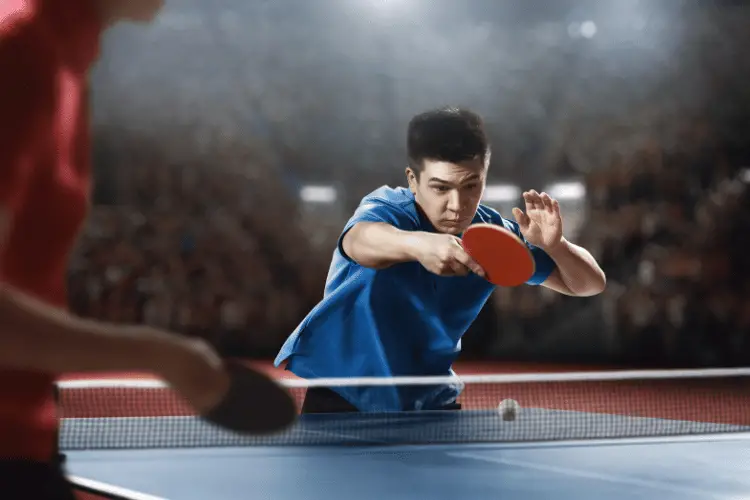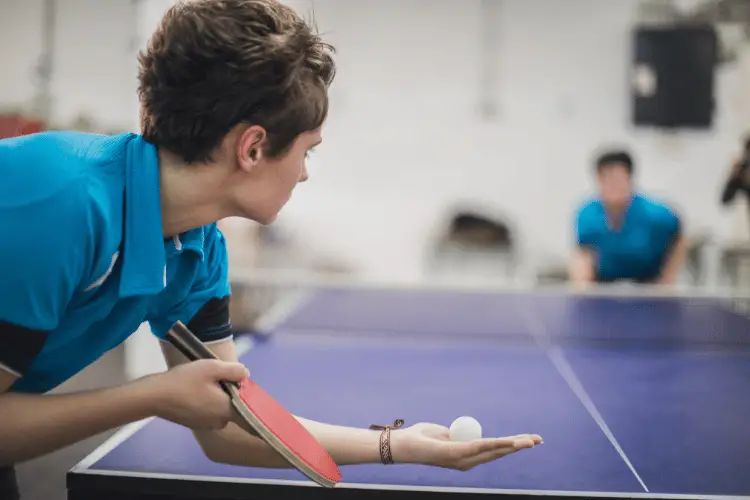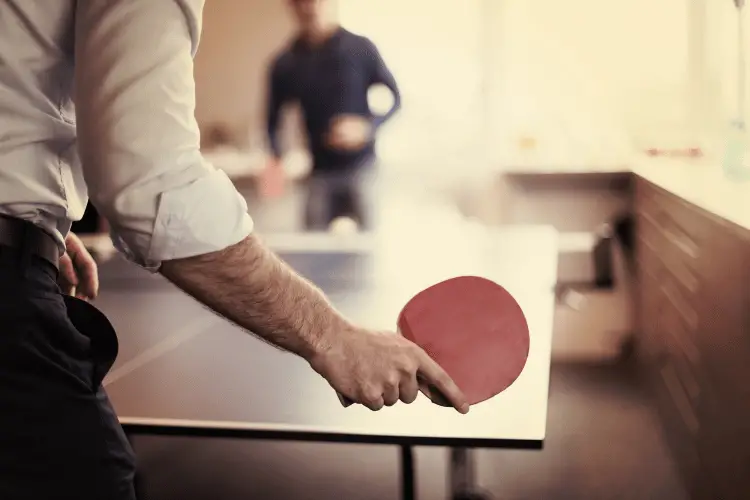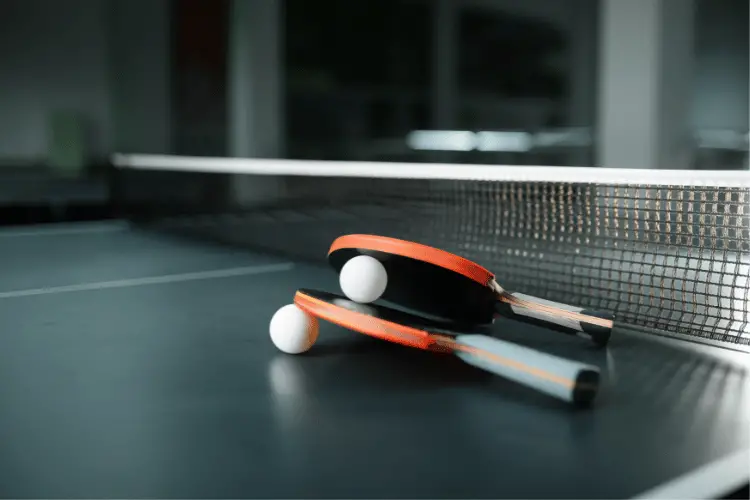With about 300 million players around the world, ping-pong, also known as table tennis, has been growing in popularity in recent years, and it’s easy to see why. Apart from being a fun way to spend time with friends and family, this activity offers several health benefits.
What are the health benefits of ping-pong? That’s what we set out to explore in this article. So stick around for all the details!
1. Improves Hand-Eye Coordination
Improved hand-eye coordination is one of the primary benefits of table tennis, which might not come as a surprise. After all, the game isn’t the most physically demanding sport. Instead, it requires a high level of concentration and quick reflexes to constantly hit the ball.
But what is hand-eye coordination? And why is it important?
As the name implies, hand-eye coordination controls eye and hand movements together to process visual input.
Although hand-eye coordination results from two organs working together, the movement isn’t simultaneous.
Usually, the human gaze works first; the eyes fixate on a target, collecting spatial information. The brain then processes these signals and sends them to your arms and hands to guide their movement.
Unfortunately, as we age, we our abilities decline with tasks that require coordination. However, eye-hand workouts can help keep those skills intact and maintain your brain’s sharpness, even as you age!
The best part is that those eye-hand dexterities aren’t only helpful in playing table tennis. You need those skills for day-to-day tasks such as writing, eating, carrying objects, and more.
2. Increases Speed and Agility

Playing table tennis contributes to better agility and speed performance. Since people often use both terms interchangeably, let’s explain them before discussing how table tennis hones those skills.
In athletics, speed refers to moving quickly over a set distance in a certain direction. For example, speed measures how fast a runner can complete a 100-meter dash. It’s expressed in units of time, such as seconds or minutes.
Agility, on the other hand, refers to a person’s ability to change directions while still maintaining quick movements. It also includes decelerating (slowing down) in different directions, like when playing soccer.
Both skills promote rapid movement and require a high degree of coordination between the brain and muscles. Not only that, but those abilities’ development depends on cognitive functions, such as perception, processing speed, faster reaction time, and working memory.
Guess which sport combines all those abilities? Table-tennis!
So, by playing ping-pong regularly, you not only get the physical benefits of exercise but also improve your cognitive function. Consequently, you increase your speed and agility. Don’t just take my word for it, though.
A study done on middle-aged and older people compares agility performance between table tennis players and sedentary adults. The scientists performed tests to measure movement reactions to visual inputs.
As you might have guessed, those who played ping-pong had better agility and faster reaction times compared to those who led a sedentary lifestyle.
3. Develops Accuracy
Table tennis can help develop accuracy through the precise, controlled movements required to play the game.
Think about it. The first thing ping-pong players learn is to perfect their technique. Regular practice is essential for improving table tennis skills, such as grip, stance, and stroke.
When you repeat certain movements over time, the brain creates muscle memory for that task. The best part is that those motor learning skills last long term! As a result, you can do those repeated actions without much conscious effort.
Combine this with improved hand-eye coordination and increased cognitive function, and you’re set!
4. Improves Balance
It comes as no surprise that table tennis can help improve your balance. The sport requires constant shifting in direction, quick, precise footwork, and visual tracking to play ping-pong successfully.
Additionally, table tennis requires rotating and twisting movements, which can, to a degree, improve core strength.
Now, you might already know that core stability is crucial for proper balance, and by core, I don’t mean abdominal muscles only. Your torso involves different muscle groups, including the pelvic floor, lower back, and hips.
Training those muscles to work in harmony is vital for day-to-day activities and sports.
And aside from the core, your balance depends on processing visual input and proprioception, among other things.
Practicing table tennis helps increase proprioceptive abilities, particularly for tasks that require the use of the dominant limb.
For those who don’t know, the former refers to the body’s ability to perceive its position, movement, and orientation in space.
Several sensory receptors, called proprioceptors, in the muscles, joints, and tendons mediate proprioception.
Those receptors provide information about the body’s movement and position to the central nervous system, allowing the brain to adjust and control movement accordingly—all of which lead to improved balance. That comes in handy, especially for elders.
One study shows that regular table tennis training doesn’t only improve physical fitness among the elderly, but it also boosts their overall balance. Those who played ping-pong could hold different standing postures longer than the group that didn’t practice table tennis.
5. Burns Calories
Sure, table tennis won’t burn many calories like other strenuous physical activities, such as running or HIIT—it’s not really an exercise unless you’re completely out of shape.
You also won’t be gaining muscle mass. The latter requires resistance training that creates micro-tears in the fibers. Your body then heals the tissues, increasing their size to make the myofibrils stronger, a process known as hypertrophy.
Still, playing table tennis burns more calories than sitting on the couch, right? In fact, it does.
Of course, playing at a professional level is more physiologically demanding than playing for leisure since it involves fast movements and great coordination. That’s why seasoned ping-pong players burn more calories than you or I when we play.
6. Boosts Brain Function
As mentioned earlier, table tennis improves various neurological and cognitive functions, such as hand-eye coordination, muscle memory, and proprioception. However, those aren’t the only benefits that help you develop mental acuity.
Long-term table tennis training facilitates visuospatial cognitive processing in athletes. It does so by improving the neuroplasticity in the right hemisphere, the part of the brain responsible for spatial abilities.
The question is this: what is neuroplasticity?
As the name implies, neural plasticity refers to the neural network’s ability to change and function differently than it used to. It results from new learning experiences, memory formation, or brain damage.
Such brain rewiring can sharpen memory, concentration, and cognitive skills. In the case of ping-pong, it strengthens spatial processing, which is essential for life activities.
For example, the former ability allows you to understand locations, dimensions, and how objects are related. It helps you pack your car’s trunk, read a map, ride a bike, and more!

7. Fights off Neurological Diseases
Generally, exercise boosts your immune system and supports overall health, which helps prevent diseases.
For that reason, it’s no surprise that ping-pong provides the same health benefits. Not only that, but practicing table tennis can also help prevent neurological diseases like dementia!
For those wondering, dementia is an umbrella term that describes neurological conditions that cause a loss in brain function.
Those diagnosed with this disease experience irreversible neuronal damage. As a result, they lose the ability to think and remember, among other symptoms that affect daily life.
The underlying causes of dementia remain a mystery. However, people usually develop cognitive decline as they age.
Luckily, studies show that aerobic exercises, like table tennis, reduce the risks of progressive decline in brain function.
As you might expect, physical activity increases blood circulation to the brain and prevents cerebral blood vessels from hardening. Additionally, the sport induces neuroplastic alterations that improve cognition.
Such benefits help maintain mental acuity and can reduce the chances of developing dementia.
8. Improves Parkinson’s Disease Symptoms
Parkinson’s is another progressive neurological disease that damages the nerves and affects daily activities. The former illness mainly impairs the substantia nigra, a brain area responsible for dopamine production, planning, and problem-solving, among other functions.
For those who don’t know, dopamine is a neurotransmitter that regulates body movement. Reduced dopamine production causes many symptoms of Parkinson’s disease.
While there isn’t a cure for this neurological illness, medications and physical exercise can help alleviate the symptoms. That’s especially true with table tennis.
Since the game requires cognitive skills, it activates brain areas responsible for reasoning, even after being affected by Parkinson’s.
Additionally, ping-pong focuses on coordination and balance and improves spatial cognition—all of which can improve the motor symptoms of Parkinson’s disease.
9. Reduces Stress
Physical activity, in general, is known to alleviate mental health issues, and table tennis is no exception! While you might not agree at first, exercising is fun. Plus, it helps reduce stress and boost your mood.
During physical activity, your body reduces the production of stress hormones, such as adrenaline and cortisol. The former are hormones responsible for regulating the fight-or-flight response.
While those neurotransmitters are vital during dangerous situations, they cause anxiety and nervousness.
Challenging your friends to a table tennis match can help you get rid of that stress.
What’s more, exercising pumps up endorphin production, the feel-good hormone. As a result, it can help boost your mental health and ease symptoms of anxiety and depression.
10. Encourages Social Interaction

Ping-pong isn’t an individual game; it requires two or four players. That provides a great opportunity for social interaction and developing communication skills. Those perks make the sport excellent for teens.
Think about it. Table tennis promotes healthy competition among players. In team play, teenagers can learn to work together. Not to mention the large community you get to be a part of. After all, table tennis is the sixth most popular sport in the world, with over 850 million fans!
So, there are sure to be various clubs and leagues near you that you can join to learn about this enjoyable sport.
Even if you don’t want to play professional ping-pong, you can have it for use at gatherings. Trust me, there’s always someone who wants to play.
So, whether it’s to play competitively or for recreational purposes, ping-pong is a great way for teenagers to pass time and stay out of trouble during their rebellious years.
How Many Calories Are Burned in 30 Minutes of Ping-Pong?
On average, a person can burn around 150-200 calories in a 30-minute ping-pong session. That’s roughly equivalent to the number of calories burned in 30 minutes of moderate-intensity walking.
So, by playing 30 minutes of ping-pong daily for a whole year, you can expect to burn between 54,750-73,000 calories. Since a pound of fat contains around 3500 calories, you can lose approximately 16-20 pounds in a year.
Keep in mind that playing ping-pong at a higher intensity, such as in competitive matches, results in greater calorie burn. Generally, professional table tennis players can burn up to 300 calories when playing for 30 minutes.
Other factors affecting calories burned include body composition, age, gender, and genetics.
Wrapping Up
As you can see, ping-pong is more than just a fun game; it’s a great way to improve your physical and cognitive abilities. The sport helps you enhance your hand-eye coordination, speed, agility, and accuracy.
However, the benefits of ping-pong don’t stop there. Regular table tennis practice can help fight off neurological diseases such as dementia and Parkinson’s. Not to mention, it can be a fun way to burn calories.
So, if you’re looking for an engaging way to stay healthy, grab a paddle and start playing ping-pong!
References
- https://www.ncbi.nlm.nih.gov/pmc/articles/PMC6763066/
- https://www.health.harvard.edu/staying-healthy/activities-to-sharpen-your-eyehand-coordination
- https://www.ncbi.nlm.nih.gov/pmc/articles/PMC9301166/
- https://www.researchgate.net/publication/276511689_Proprioceptive_Ability_of_Fencing_and_Table_Tennis_Practioners
- https://www.masterclass.com/articles/what-is-muscle-memory
- https://www.mayoclinic.org/healthy-lifestyle/fitness/in-depth/core-exercises/art-20044751
- https://www.researchgate.net/publication/276511689_Proprioceptive_Ability_of_Fencing_and_Table_Tennis_Practioners
- https://old.scielo.br/scielo.php?script=sci_arttext&pid=S2448-24552022000100257
- https://my.clevelandclinic.org/health/articles/7050-aerobic-exercise
- https://www.ncbi.nlm.nih.gov/pmc/articles/PMC3772576/
- https://www.mdpi.com/2076-3425/12/12/1607
- https://cognitiveresearchjournal.springeropen.com/articles/10.1186/s41235-021-00274-5
- https://www.cdc.gov/aging/dementia/index.html
- https://www.mdpi.com/2673-8392/2/3/107
- https://my.clevelandclinic.org/health/body/23010-substantia-nigra-sn
- https://www.sciencedirect.com/science/article/pii/S2590112520300542
- https://www.mayoclinic.org/healthy-lifestyle/stress-management/in-depth/exercise-and-stress/art-20044469
- https://www.medicalnewstoday.com/articles/325176
- https://www.mayoclinic.org/healthy-lifestyle/weight-loss/in-depth/metabolism/art-20046508


